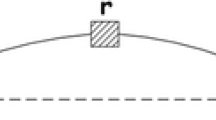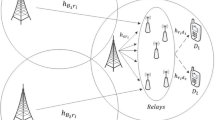Abstract
In the recent years, cooperative communication is shown to be a promising technology to improve the spatial diversity without additional equipments or antennas. With this communication paradigm, energy can be saved by effective relay assignment and power allocation while achieving the required bandwidth for each transmission pair. Thus, this paper studies the joint relay node assignment and power allocation problem which aims to minimize the total power consumption of the network while providing the efficient bandwidth service. We first analyze the minimum power consumption under the bandwidth requirement for different communication modes. Based on the analytical results, we present a polynomial-time algorithm JRPA to optimally solve this problem. The algorithm first constructs a weighted bipartite graph G based on the given transmission pairs and relay nodes. Then, we adopt the KM method to find out a saturated matching M, and assign the relay nodes to the transmission pairs based on the matching. The optimality of the algorithm is also proved. The simulation results show that JRPA algorithm can save about 34.2% and 18.9% power consumptions compared with the direct transmission and ORA schemes in many situations.











Similar content being viewed by others
References
Shi, Y., Sharma, S., Hou, Y. T., & Kompella, S. (2008). Optimal relay assignment for cooperative communications. In MobiHoc’08.
Laneman, J. N., Tse, D. N. C., & Wornell, G. W. (2004). Cooperative diversity in wireless networks: Efficient protocols and outage behavior. IEEE Transactions on Information Theory, 50(12), 3062–3080.
Sendonaris, A., Erkip, E., & Aazhang, B. (2003). User cooperation diversity—part I: System description. IEEE Transactions on Communications, 51(11), 1927–1938.
Bletsas, A., Khisti, A., Reed, D., & Lippman, A. (2006). A simple cooperative diversity method based on network path selection. IEEE Journal on Selected Areas in Communications, 24(3), 659–672.
Cai, J., Shen, S., Mark, J. W., & Alfa, A. S. (2008). Semi-distributed user relaying algorithm for amplify-and-forward wireless relay networks. IEEE Transactions on Wireless Communications, 7(4), 1348–1357.
Zhao, Y., Adve, R. S., & Lim, T. J. (2006). Improving amplify-and-forward relay networks: Optimal power allocation versus selection. In Proceedings of IEEE international Symposium on information theory (pp. 1234–1238), Seattle, July 9–14.
Adeane, J., Miguel, R. D, & Wassell, I. J. (2005). Optimum power allocation in cooperative networks. In 12th International conference on telecommunications (ICT 2005), 3–6 May 2005, Cape Town, South Africa.
Badr, M., Strinati, E. C., & Belfiore, J.-C. (2008). Optimal power allocation for hybrid amplify-and-forward cooperative networks. In IEEE vehicular technology conference, 2008. VTC Spring 2008.
van der Meulen, E. C. (1971). Three terminal communication channels. Advances in Applied Probability, 3, 120–154.
Cover, T. M., & EL Gamal, A. (1979). Capacity theorems for the relay channel. IEEE Transactions on Information Theory, 25(5), 572–584.
Ng, T. C.-Y., & Yu, W. (2007). Joint optimization of relay strategies and resource allocations in cooperative cellular networks. IEEE Journal on Selected Areas in Communications, 25(2), 328–339.
Munkres, J. (1957). Algorithms for the assignment and transportation problems. Journal of the Society for Industrial and Applied Mathematics, 5, 32–38.
Acknowledgments
This paper is supported by the National Grand Fundamental Research 973 Program of China under Grant No. 2006CB303-006, the National Science Foundation of China under Grant No. 60803116, Special Grade of the Financial Support from China Postdoctoral Science Foundation under Grant No. 200902298, China Postdoctoral Science Foundation funded project under Grant No. 20080430103, the Dean Fund of the Chinese Academy of Science, and the Fundamental Research Funds for the Central Universities.
Author information
Authors and Affiliations
Corresponding author
Rights and permissions
About this article
Cite this article
Xu, H., Huang, L., Wang, G. et al. Joint relay assignment and power allocation for cooperative communications. Wireless Netw 16, 2209–2219 (2010). https://doi.org/10.1007/s11276-010-0254-2
Published:
Issue Date:
DOI: https://doi.org/10.1007/s11276-010-0254-2




